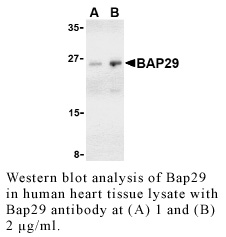Anti-Human B Cell Receptor-Associated Protein 29 (CT) (BAP29)
Data
- -
- -
Antibody DetailsProduct DetailsReactive Species Human Host Species Rabbit Immunogen PN:B497 Product Concentration 0.5 mg/ml Formulation This polyclonal antibody is formulated in phosphate buffered saline (PBS) pH 7.4 containing 0.02% sodium azide as a preservative. Storage and Handling This polyclonal antibody is stable for at least one week when stored at 2-8°C. For long term storage, aliquot in working volumes without diluting and store at –20°C in a manual defrost freezer. Avoid Repeated Freeze Thaw Cycles. Country of Origin USA Shipping Next Day Ambient RRIDAB_2828219 Each investigator should determine their own optimal working dilution for specific applications. See directions on lot specific datasheets, as information may periodically change. DescriptionDescriptionSpecificity Rabbit Anti-Human B Cell Receptor-Associated Protein 29 (BAP29) recognizes an epitope near the C-terminus of Human, Mouse and Rat BAP29. This polyclonal antibody was purified using affinity chromatography. Background Bap29 and the related protein Bap31 are endoplasmic reticulum (ER) and ER-vesicle membrane proteins and members of the B-cell receptor-associated protein family.1,2 These two proteins are highly homologous and can form homo- and heterodimers. Both Bap29 and Bap31 interact with membrane-bound immunoglobulins (mIgs), such as IgM and IgD, which with Ig-α/Ig-β heterodimers form B cell antigen receptors. Binding of the Bap29/Bap31 heterodimer correlates with the ER retention of non-Ig-α/Ig-β bound mIg complexes, suggesting that Bap29 and Bap31 may act as chaperones transmembrane regions of various proteins. Bap29 possesses multiple isoforms. PubMed References & Citations1. Ng, F. et al. (1997) J. Cell Biol. 139:327 2. Schamel, W. et al. (2003) Proc. Natl. Acad. Sci. USA 100:9861 Technical ProtocolsCertificate of Analysis |



